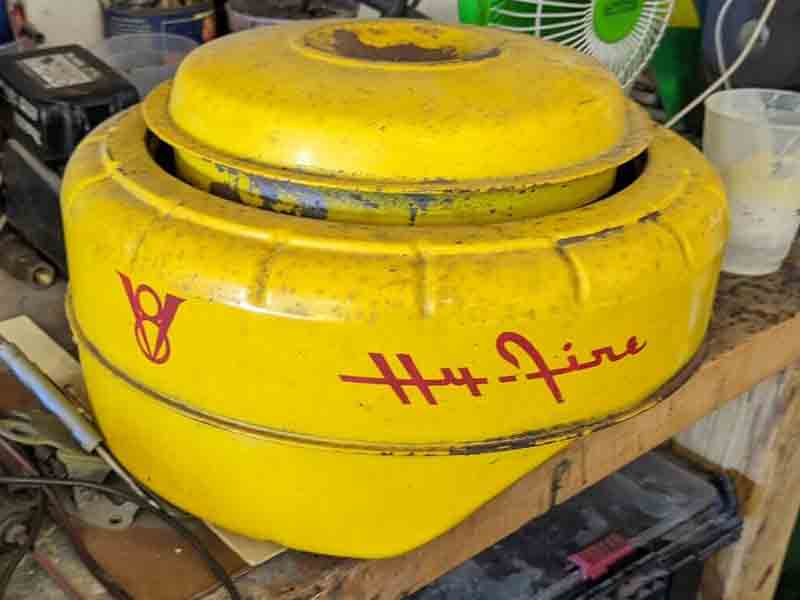I’ve been busy working to create content for my new YouTube channel called “The Shadetree Garage.” The channel’s origins actually go back to my 1956 Plymouth, which is the vehicle I’ll be working on while creating content for that channel.
Currently, I’m trying to get all of my old bodywork tools together in one spot, get them rehabilitated into some kind of working order, and locate supplies.
At one time, I had six lockers with shelving that I had full of sandpaper, body filler, tools, etc. Well, the lockers are buried in the barn, and they’re empty of tools anyway. Of course, this was 39 years ago, when was a 25-year-old starry-eyed bodyman.
For more than the last year I’ve been studying the current state of the art in autobody repair and painting.
Some of it hasn’t changed much; other aspects have literally been reinvented. Its all pretty amazing … as well as entertaining. There’s old guys like me who are bringing their O.G. work methods into the 21st Century. There are some really interesting arguments that happen among on YouTube creators.
DEBATE 1: BONDO ON CARDBOARD? Guys my age (and older) grew up mixing body filler on whatever surface they could find, which often was simple cardboard. Mixing Bondo on cardboard was never an issue — until the YouTube age. Self-proclaimed autobody experts deemed mixing bondo on cardboard “old fashioned” and a sin against good autobody procedures.
You don’t have to look far to fine YouTubers who proclaim that board board will somehow taint the body filler, making it useless and nearly guaranteed to fail.
DEBATE 2: BARE HANDS ON UNPAINTED STEEL? For my years working on cars, I never considered wearing any kind of gloves unless I was welding. In fact, like most old-school body men, I depend on my hands to feel if a panel is level or not. Just my hands, unadorned with gloves.
This, of course, is an absolute no-no to many 21st Century bodymen. Why? Well, the oils from your skin will contaminate the steel panel. If that happens, woe to you and your paint job because nothing will adhere — ever! Body filler and paint will just slough off!
My experience is that its fine to touch bare steel when working a body panel. The secret of course is you have to keep the panels clean; a simple application of grease and wax remover prior to paint and primer eliminated potential problems.
TAKING STOCK OF NEW AND OLD. So for now, the Shadetree Garage is mostly about getting things pulled together, and making old tools serviceable again. Tools I can repair get replaced.
OIL TO PAPER AIR CLEANER CONVERSION. My current project has been converting an original 1956 Plymouth oil bath air cleaner into one that appears original but uses a replaceable paper filter rather than the original oil bath.
This isn’t an original idea; I saw a post on one of the classic car websites about a guy who did a very similar project.
The original air cleaner clamps onto the top flange of the stock 2-barrel carb; to remove the entire air cleaner, you must loosen the clamp using the handle that protrudes out the back of the unit.
Editor’s note: The air cleaner pictured is nearly identical to the existing one on my 1956 Plymouth. The one I’m modifying has a slightly different lid. The one I’m modifying was originally yellow but later painted red.
The original air cleaner has a top that is held down with the typical wing nut. The wing nut doesn’t secure the entire air cleaner, just the center section which also includes the actual filtering mechanism. The bottom of this center section is immersed in the actual oil bath; incoming air to the carb must pass through the air cleaner, where dust and impurities are allegedly “filtered.”
Today I finish sanded the body filler on the body of the air cleaner and primered it using an ancient Harbor Freight cheap-ass purple gun. This one was old, and I rescued from the refuse pile in the barn.
The next task is to cut the lid section away from the actual filtering section. I have to cut several inches off the center section and then I’ll finish it by welding a plat plate to close off the lid so it neatly will mate with the paper filter.
One of the next tasks I need to complete is to assemble the Quick Jack 5000. It will be much easer to work on the lower section of the doors and rockers after raising the car.
I’m not sure if I’ll shoot video of the Quick Jack assembly; there’s not shortage of Quick Jack videos on YouTube as it is.
So check out The Shadetree Garage. Wish my new YouTube endeavor some luck, lol!
